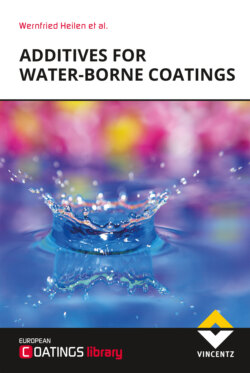Читать книгу Additives for Water-borne Coatings - Wernfried Heilen - Страница 15
На сайте Литреса книга снята с продажи.
2.1.4.1Viscosity
ОглавлениеStabilisation of the pigment particles reduces the interactions between them, leading to greater mobility and ultimately to lower viscosity. Electrostatic stabilisation utilises Coulomb forces, which are stronger than the forces arising from changes in entropy due to steric stabilisation. For this reason, the reduction in viscosity brought about by an anionic additive is greater than that of a non-ionic additive which employs only steric hindrance to stabilise the particles. If high pigment loadings are required, electrostatic stabilisation should be considered.
Another important effect is the way in which viscosity is reduced when additives are used in different quantities. An additive which predominantly stabilises by electrostatic repulsion is adsorbed on the pigment surface when added to the grind and immediately decreases the interaction between the pigment particles, resulting in a strong reduction in viscosity. At higher addition levels the effect does not continue and, in fact, a small increase in viscosity can be observed arising from the higher concentration of polymer and the resulting higher solids content.
Figure 2.3: Viscosity behaviour and additive dosage in direct grind
High-polymer additives which stabilise by steric or electrosteric effects exhibit a different behaviour. At a particular level of addition there is a maximum reduction in viscosity. Amounts below this are not sufficient to stabilise the pigment particles which can interact with each other, leading to a high viscosity. However, amounts above the optimum also lead to high viscosity of the pigment concentrate. This increase cannot be explained by the higher amount of polymer in the formulation. Furthermore, the additive molecules in the outer polymer shell are not fully orientated and these can also interact with the polymer shells of other pigment particles. This bridging leads to reduced mobility of the pigment particles and, in consequence, to higher viscosity.
Figure 2.4: Viscosity behaviour and additive dosage in pigment concentrates
